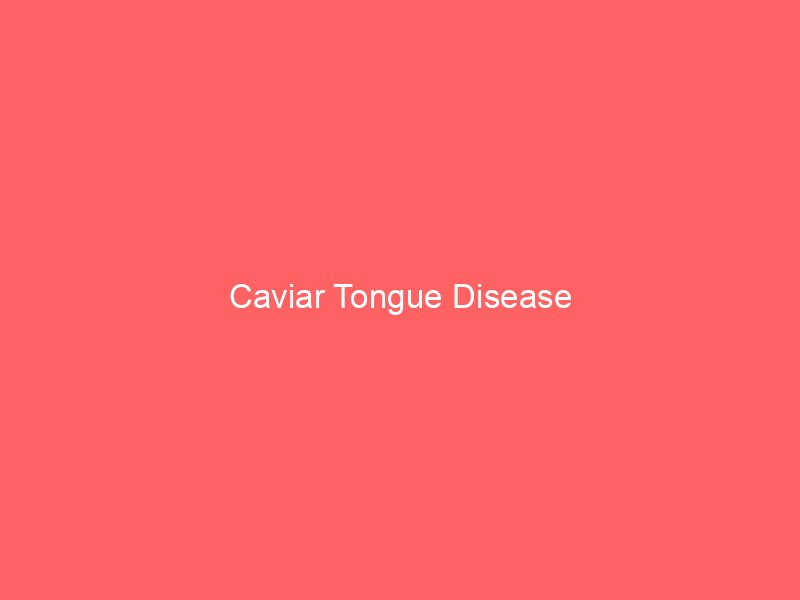
Caviar tongue disease, also known as transient lingual papillitis or lie bumps, is a benign condition that affects the tongue. It is characterized by the appearance of small, painful bumps or raised areas on the surface of the tongue, often with a white or red color.
The exact cause of Caviar tongue disease is unknown, but it is believed to be related to irritation or inflammation of the tongue’s papillae, the small bumps on the tongue’s surface that contain taste buds. Possible triggers of Caviar tongue disease include stress, hormonal changes, certain foods or beverages, and viral infections.
Causes
While the exact causes of transient lingual papillitis are not fully understood, there are several factors that may contribute to its development:
- Trauma or irritation: One of the most common causes of transient lingual papillitis is trauma or irritation to the tongue. This can occur from accidentally biting the tongue, consuming hot or spicy foods, or using oral hygiene products that contain harsh chemicals.
- Viral infections: Some cases of transient lingual papillitis are thought to be caused by viral infections, such as the herpes simplex virus. These infections can cause inflammation and swelling of the tongue, which can lead to the development of painful bumps.
- Allergies: Certain foods and substances can trigger an allergic reaction in some people, which can lead to the development of transient lingual papillitis. Common allergens include nuts, shellfish, and certain types of medication.
- Hormonal changes: Some people may experience transient lingual papillitis as a result of hormonal changes, such as those that occur during menstruation or pregnancy. These changes can affect the immune system, making the tongue more susceptible to inflammation and irritation.
- Stress: Stress and anxiety can weaken the immune system and increase the risk of developing transient lingual papillitis. This may be because stress hormones can cause inflammation and irritation throughout the body, including the tongue.
While transient lingual papillitis is typically a benign condition that resolves on its own within a few days, it can be uncomfortable and painful. If you experience persistent or severe symptoms, it is important to speak with your healthcare provider to rule out any underlying health conditions or infections.
Symptoms
The symptoms of transient lingual papillitis include:
- Small, red or white bumps on the tongue
- Pain or discomfort in the affected area
- Swelling or inflammation of the tongue
- Changes in taste perception
- Tingling or burning sensation in the mouth
- Difficulty eating or drinking
The bumps may appear suddenly and can last for a few days to a week. The condition is usually harmless and resolves on its own without treatment. However, if the symptoms persist or become severe, a doctor may recommend treatment options such as pain relievers or oral rinses to alleviate discomfort.
Diagnosis
Diagnosis of TLP is typically based on the symptoms and the appearance of the tongue. The papillae on the tongue will appear as small, red or white bumps that are slightly raised, and they can cause discomfort or pain. A doctor may examine the tongue and take a medical history to rule out other conditions that can cause similar symptoms.
There are no specific tests for TLP. If the symptoms persist, a doctor may order additional tests to rule out other underlying conditions, such as oral thrush, bacterial infections, or allergic reactions.
Treatment
The treatment of TLP is usually focused on alleviating the symptoms and reducing discomfort. Here are the main treatments for transient lingual papillitis:
- Saltwater rinse: A simple saltwater rinse can help to reduce inflammation and relieve pain caused by TLP. Mix half a teaspoon of salt in a glass of warm water and swish the mixture in the mouth for 30 seconds before spitting it out.
- Over-the-counter pain relievers: Non-steroidal anti-inflammatory drugs (NSAIDs) such as ibuprofen or acetaminophen can help to reduce pain and inflammation caused by TLP.
- Ice therapy: Applying an ice pack to the affected area can help to reduce swelling and numb the pain.
- Oral anesthetic: Over-the-counter oral anesthetics such as benzocaine or lidocaine can help to numb the tongue and reduce pain caused by TLP.
- Avoiding irritants: Spicy, acidic, and rough-textured foods and drinks can irritate the inflamed papillae, causing further discomfort. It is best to avoid these foods and drinks until the condition resolves.
- Good oral hygiene: Maintaining good oral hygiene can help to prevent the occurrence of TLP. Brushing the tongue regularly can help to remove bacteria and prevent inflammation of the papillae.
TLP usually resolves within a few days or weeks, but if the symptoms persist or become severe, it is recommended to seek medical attention from a healthcare professional.




 Shop From Rxharun..
About Us...
Editorial Board Members..
Developers Team...
Team Rxharun.
Shop From Rxharun..
About Us...
Editorial Board Members..
Developers Team...
Team Rxharun.